Adam Birtwistle (born 1959) is a British artist whose idiosyncratic portraits of composers and musicians are represented in the National Portrait Gallery.
Adam Birtwistle (born 1959) is a British artist whose idiosyncratic portraits of composers and musicians are represented in the National Portrait Gallery.
Adam Birtwistle was born in Eton in 1959 and is the son of the composer Sir Harrison Birtwistle [1] and brother of the artist Silas Birtwistle. [2] [3] After attending schools in Britain and the US, he studied sculpture for four years at Chelsea School of Art and followed this with two years at the Arch Bronze Foundry, working with Ben Kneale. [1] In 1985 he took part in designing masks and costumes for one of his father’s music theatre pieces at Dartington Summer School of Music.[ citation needed ]
In 1986 he attended printing classes at the Royal Academy while preparing his first one-man show in London with Piano Nobile Fine Paintings. Since then he has regularly held solo shows at Piano Nobile and completed numerous commissions. [1]
Two paintings by Birtwistle have been purchased by the National Portrait Gallery in London: a portrait of his father, Sir Harrison, [4] and one of Elvis Costello (Declan McManus). [5] Other musicians, conductors and composers to feature in his paintings include the pianist Alfred Brendel, and the composers Hans Werner Henze and Sir Michael Tippett.
In 1999, he was commissioned by Curtis Price to paint a portrait of his father for Dukes Hall at the Royal Academy of Music.
The following year, 2000, he was asked to paint portraits of six composers, whose operas were to be featured during the 2001 Glyndebourne Festival: Mozart, Beethoven, Verdi, Janáček, Britten and again Adam’s father, Sir Harrison. He was subsequently commissioned by Glyndebourne to paint the film and stage director, Sir Peter Hall, the artist and stage designer, David Hockney, the opera singer Anja Silja, as well as Sir George Christie, the then chairman of the Glyndebourne Festival, and his wife, Lady Christie.
Among others, Birtwistle has done portraits of the painters Craigie Aitchison and Peter Blake. Fascinated by ‘performers’ of all descriptions, his subjects vary from the astronomer, Sir Patrick Moore, and Winston Churchill, through to the actor Jeremy Irons and Dame Marjorie Scardino. In 2008 he was commissioned by the broadcaster Nick Ross to produce a series of ten paintings called "Black is White" to confront racial stereotypes. The exhibition was launched by Trevor Philips who chairs Britain's Commission for Equalities and Human Rights. The cycle includes a triptych of arguably the three most significant American black civil rights activists, Marcus Garvey, Dr Martin Luther King and Malcolm X, along with race reversal portraits of the iconic faces of Marilyn Monroe, Jessye Norman, Charles Dickens, Albert Einstein, Pablo Picasso, Abraham Lincoln and Birtwistle's second take on Sir Winston Churchill though this time painted as he would have looked with black skin pigmentation.
Lord Gowrie, chairman of the Art Council (1994/1998), described Adam Birtwistle as "an artist who brings off something uncommon and difficult. He is a serious painter with wit. This quality shows in both composition and brushwork." [6]
Dr Charles Saumarez Smith, secretary and chief executive of the Royal Academy and formerly director of the National Gallery, regarded Adam Birtwistle as "one of the best of his generation" (*), while art critic Godfrey Barker called him "…one of our most distinguished portrait painters in what is, presently, a Golden Age of Portraiture in Britain." [6]
Object of the Week Daily Telegraph 20 May 2002... Glyndebourne, the celebrated Sussex opera house, unveiled six paintings of people closely associated with it. They were all by Adam Birtwistle.[ citation needed ]
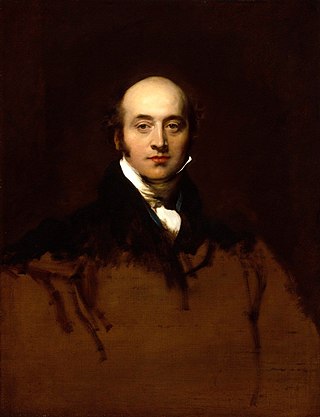
Sir Thomas Lawrence was an English portrait painter and the fourth president of the Royal Academy. A child prodigy, he was born in Bristol and began drawing in Devizes, where his father was an innkeeper at the Bear Hotel in the Market Square. At age ten, having moved to Bath, he was supporting his family with his pastel portraits. At 18, he went to London and soon established his reputation as a portrait painter in oils, receiving his first royal commission, a portrait of Queen Charlotte, in 1790. He stayed at the top of his profession until his death, aged 60, in 1830.

Sir Harrison Birtwistle was an English composer of contemporary classical music best known for his operas, often based on mythological subjects. Among his many compositions, his better known works include The Triumph of Time (1972) and the operas The Mask of Orpheus (1986), Gawain (1991), and The Minotaur (2008). The last of these was ranked by music critics at The Guardian in 2019 as the third-best piece of the 21st century. Even his compositions that were not written for the stage often showed a theatrical approach. A performance of his saxophone concerto Panic during the BBC's Last Night of the Proms caused "national notoriety". He received many international awards and honorary degrees.

Walter Richard Sickert was a Kingdom of Bavaria-born British painter and printmaker who was a member of the Camden Town Group of Post-Impressionist artists in early 20th-century London. He was an important influence on distinctively British styles of avant-garde art in the mid and late 20th century.
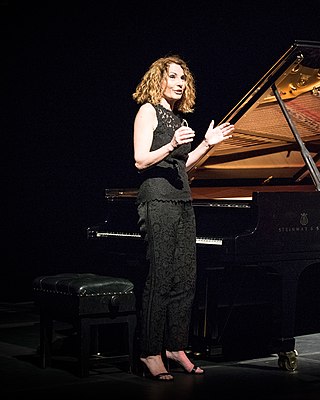
Joanna Clare MacGregor is a British concert pianist, conductor, composer, and festival curator. She is Head of Piano at the Royal Academy of Music and a professor of the University of London. She was artistic director of the International Summer School & Festival at Dartington Hall from 2015 to 2019.
Graham Vivian Sutherland was a prolific English artist. Notable for his paintings of abstract landscapes and for his portraits of public figures, Sutherland also worked in other media, including printmaking, tapestry and glass design.

Ilya Yefimovich Repin was a Ukrainian-born Russian painter. He became one of the most renowned artists in Russia in the 19th century. His major works include Barge Haulers on the Volga (1873), Religious Procession in Kursk Province (1880–1883), Ivan the Terrible and His Son Ivan (1885); and Reply of the Zaporozhian Cossacks (1880–1891). He is also known for the revealing portraits he made of the leading literary and artistic figures of his time, including Mikhail Glinka, Modest Mussorgsky, Pavel Tretyakov, Pantaleon Szyndler, and especially Leo Tolstoy, with whom he had a long friendship.
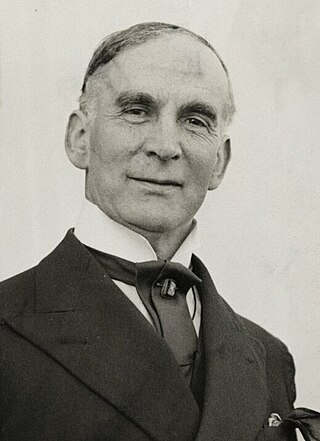
Francis Owen SalisburyCVO was an English artist who specialised in portraits, large canvases of historical and ceremonial events, stained glass and book illustration. In his heyday he made a fortune on both sides of the Atlantic and was known as "Britain's Painter Laureate". His art was steadfastly conservative and he was a vitriolic critic of Modern Art – particularly of his contemporaries Picasso, Chagall and Mondrian.
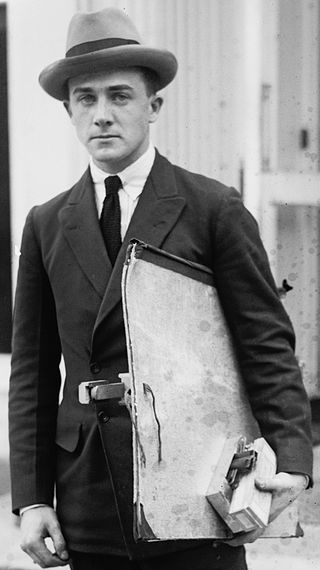
Lt. Col. Simon Edmund Vincent Paul Elwes, was a British war artist and society portrait painter whose patrons included presidents, kings, queens, statesmen, sportsmen, prominent social figures and many members of the British Royal Family. He was a favorite of Queen Elizabeth The Queen Mother.
David Bruce is a British composer and a YouTuber.
Geoffrey Burnand was an English painter, theatrical designer and mural artist. His distant relatives included the 19th Century Swiss painter Eugène Burnand and Sir Francis Burnand, editor of Punch magazine from 1880-1906.

The Second Mrs Kong is an opera in two acts, with music by Sir Harrison Birtwistle to a libretto by Russell Hoban. Glyndebourne Touring Opera first staged the opera on 24 October 1994. The cast included Philip Langridge, Helen Field and Michael Chance. Tom Cairns designed and directed the production, in collaboration with choreographer Aletta Collins. Elgar Howarth was the conductor. This production was recorded for the National Video Archive of Performance by the V&A Theatre Museum. This recording is available to view by appointment at the V&A Collections Centre and Reading Room in Olympia, London.

Music in the Tuileries is an 1862 oil-on-canvas painting by Édouard Manet. It is owned by the National Gallery, London and the Hugh Lane Gallery, Dublin as part of the shared Lane Bequest.

Cyril Mann was a British painter and sculptor who added a new dimension to figurative art by exploring the dynamic effects of sunlight in a different way from his predecessors. The artist also completed a number of sculptures, including a commission to carve a family crest for a manor house.

Pieter van der Werff was a Dutch Golden Age painter. He assisted his older brother, Adriaen van der Werff.

Stephen Plaice is a UK-based dramatist and scriptwriter who has written extensively for theatre, opera and television. In 2014 he was appointed Writer in Residence at the Guildhall School of Music and Drama. He became Professor of Dramatic Writing at the school in 2018.
Jean Esme Oregon Cooke RA was an English painter of still lifes, landscapes, portraits and figures. She was a lecturer at the Royal Academy and regularly exhibited her works, including the summer Royal Academy exhibitions. She was commissioned to make portraits by Lincoln College and St Hilda's College, Oxford. Her works are in the National Gallery, Tate and the Royal Academy collections. In the early years of her marriage, she signed her works Jean Bratby.
Michael Nicholas Snowman OBE was a British arts administrator and the chairman of the jewellers Wartski. In 2000, The Telegraph called him "one of the most influential figures in British classical music for the past 30 years".

The Portrait of Sir David Webster is a 1971 portrait by the artist David Hockney of the arts administrator David Webster. It was commissioned to mark Webster's retirement as the General Administrator of the Royal Opera House in London. The portrait hung for several decades in the opera house.
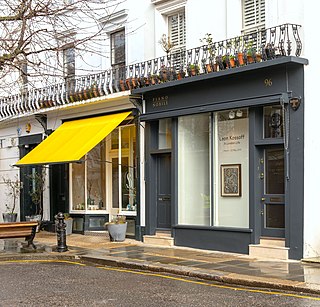
Piano Nobile is a commercial art gallery in London, England, specialising in twentieth-century British art. It was established by Dr Robert Travers at premises in Richmond in 1985. In 2000, the gallery moved to its current address at 129 Portland Road, London. In 2019, an additional gallery space was acquired at 96 Portland Road. Between 2008 and 2019, the gallery also had an exhibition space at Kings Place in King’s Cross.
George Newson is an English composer and pianist who made some important contributions to British electronic and avant garde music during the 1960s and 1970s and has subsequently composed large and small-scale works in many musical forms and styles, from songs and chamber music to choral works and opera. As a photographer, Newson has taken portraits of many of his composer contemporaries.
{{cite book}}: CS1 maint: location missing publisher (link) CS1 maint: others (link)